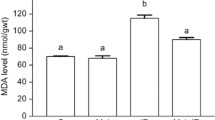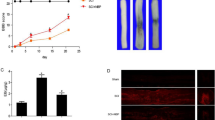Abstract
The spinal cord microcirculation plays a critically important role in maintaining the normal function of spinal cord neurons, glial cells, and axons. Previous researches were largely focused on improved neurological manifestations of spinal cord injury (SCI) while ignoring to improve spinal cord microcirculation disorder after melatonin treatment. Therefore, the mechanism of melatonin that affects blood spinal cord barrier (BSCB) integrity and microcirculation in SCI remains unclear. The present study was performed to investigate the effect of melatonin on the BSCB in a SCI mice model. Melatonin (5, 10, 25, 50, 100 mg/kg i.p.) was administered to mice immediately following SCI. Compared to the 48 h post-SCI group, mice treated with melatonin (50 mg/kg) exhibited significantly reduced BSCB permeability. Additionally, melatonin treatment restrained microvessel loss; attenuated edema; protected the tight junction proteins, endothelial cells, and pericytes; decreased the number of cell apoptosis; and reduced MMP3/AQP4/HIF-1α/VEGF/VEGFR2 expression after SCI. Above all, our results clearly demonstrated that melatonin could stabilize microvascular barrier function and microcirculation of SCI, whose mechanism was to promote the repair of the damaged BSCB.







Similar content being viewed by others
References
Allen A (1911) Surgery of experimental lesion of spinal cord equivalent to crush injury of fracture dislocation of spinal column. A preliminary report. JAMA 57:878–880
Allen A (1914) Remarks on the histopathological changes in the spinal cord due to impact. An experiment study. J Nerv Ment Dis 41:141–1147
Alvarez C, Alonso-Muriel I, Garcia G, Crespo J, Bellver J, Simon C, Pellicer A (2007) Implantation is apparently unaffected by the dopamine agonist cabergoline when administered to prevent ovarian hyperstimulation syndrome in women undergoing assisted reproduction treatment: a pilot study. Hum Reprod 22:3210–3214
Casella GT, Bunge MB, Wood PM (2006) Endothelial cell loss is not a major cause of neuronal and glial cell death following contusion injury of the spinal cord. Exp Neurol 202:8–20
Chen HY, Chen TY, Lee MY, Chen ST, Hsu YS, Kuo YL, Chang GL, Wu TS, Lee EJ (2006) Melatonin decreases neurovascular oxidative/nitrosative damage and protects against early increases in the blood–brain barrier permeability after transient focal cerebral ischemia in mice. J Pineal Res 41:175–182
Daneman R, Zhou L, Kebede AA, Barres BA (2010) Pericytes are required for blood–brain barrier integrity during embryogenesis. Nature 468:562–566
Dulmovits BM, Herman IM (2012) Microvascular remodeling and wound healing: a role for pericytes. Int J Biochem Cell Biol 44:1800–1812
Echeverry S, Shi XQ, Rivest S, Zhang J (2011) Peripheral nerve injury alters blood-spinal cord barrier functional and molecular integrity through a selective inflammatory pathway. J Neurosci 31:10819–10828
Ersahin M, Toklu HZ, Cetinel S, Yuksel M, Yegen BC, Sener G (2009) Melatonin reduces experimental subarachnoid hemorrhage-induced oxidative brain damage and neurological symptoms. J Pineal Res 46:324–332
Espino J, Bejarano I, Ortiz A, Lozano GM, Garcia JF, Pariente JA, Rodriguez AB (2010) Melatonin as a potential tool against oxidative damage and apoptosis in ejaculated human spermatozoa. Fertil Steril 94:1915–1917
Esposito E, Genovese T, Caminiti R, Bramanti P, Meli R, Cuzzocrea S (2008) Melatonin regulates matrix metalloproteinases after traumatic experimental spinal cord injury. J Pineal Res 45:149–156
Fan ZK, Cao Y, Lv G, Wang YS, Guo ZP (2013a) The effect of cigarette smoke exposure on spinal cord injury in rats. J Neurotrauma 30:473–479
Fan ZK, Lv G, Wang YF, Li G, Yu DS, Wang YS, Zhang YQ, Mei XF, Cao Y (2013b) The protective effect of salvianolic acid B on blood-spinal cord barrier after compression spinal cord injury in rats. J Mol Neurosci 51:986–993
Furuse M, Tsukita S (2006) Claudins in occluding junctions of humans and flies. Trends Cell Biol 16:181–188
Goldberg AL, Kershah SM (2010) Advances in imaging of vertebral and spinal cord injury. J Spinal Cord Med 33:105–116
Griffiths IR, Burns N, Crawford AR (1978) Early vascular changes in the spinal grey matter following impact injury. Acta Neuropathol 41:33–39
Haddadi G, Shirazi A, Sepehrizadeh Z, Mahdavi SR, Haddadi M (2013) Radioprotective effect of melatonin on the cervical spinal cord in irradiated rats. Cell J 14:246–253
Happel RD, Smith KP, Banik NL, Powers JM, Hogan EL, Balentine JD (1981) Ca2+-accumulation in experimental spinal cord trauma. Brain Res 211:476–479
Imaizumi T, Kocsis JD, Waxman SG (1997) Anoxic injury in the rat spinal cord: pharmacological evidence for multiple steps in Ca(2+)-dependent injury of the dorsal columns. J Neurotrauma 14:299–311
Josko J, Mazurek M (2004) Transcription factors having impact on vascular endothelial growth factor (VEGF) gene expression in angiogenesis. Med Sci Monit 10:RA89–RA98
Jung F (2010) From hemorheology to microcirculation and regenerative medicine: Fahraeus Lecture 2009. Clin Hemorheol Microcirc 45:79–99
Kaur C, Ling EA (2008) Blood brain barrier in hypoxic-ischemic conditions. Curr Neurovasc Res 5:71–81
Lee JY, Kim HS, Choi HY, Oh TH, Ju BG, Yune TY (2012) Valproic acid attenuates blood-spinal cord barrier disruption by inhibiting matrix metalloprotease-9 activity and improves functional recovery after spinal cord injury. J Neurochem 121:818–829
Li B, **u R (2013) Angiogenesis: from molecular mechanisms to translational implications. Clin Hemorheol Microcirc 54:345–355
Liebner S, Czupalla CJ, Wolburg H (2011) Current concepts of blood–brain barrier development. Int J Dev Biol 55:467–476
Morita K, Furuse M, Fujimoto K, Tsukita S (1999) Claudin multigene family encoding four-transmembrane domain protein components of tight junction strands. Proc Natl Acad Sci U S A 96:511–516
Noble LJ, Wrathall JR (1989) Distribution and time course of protein extravasation in the rat spinal cord after contusive injury. Brain Res 482:57–66
Noble LJ, Donovan F, Igarashi T, Goussev S, Werb Z (2002) Matrix metalloproteinases limit functional recovery after spinal cord injury by modulation of early vascular events. J Neurosci 22:7526–7535
Oudega M (2012) Molecular and cellular mechanisms underlying the role of blood vessels in spinal cord injury and repair. Cell Tissue Res 349:269–288
Oyinbo CA (2011) Secondary injury mechanisms in traumatic spinal cord injury: a nugget of this multiply cascade. Acta Neurobiol Exp (Wars) 71:281–299
Park K, Lee Y, Park S, Lee S, Hong Y, Kil Lee S (2010) Synergistic effect of melatonin on exercise-induced neuronal reconstruction and functional recovery in a spinal cord injury animal model. J Pineal Res 48:270–281
Qiu J (2009) China spinal cord injury network: changes from within. Lancet Neurol 8:606–607
Ray SK, Hogan EL, Banik NL (2003) Calpain in the pathophysiology of spinal cord injury: neuroprotection with calpain inhibitors. Brain Res Brain Res Rev 42:169–185
Ray SK, Samantaray S, Smith JA, Matzelle DD, Das A, Banik NL (2011) Inhibition of cysteine proteases in acute and chronic spinal cord injury. Neurotherapeutics 8:180–186
Saadoun S, Bell BA, Verkman AS, Papadopoulos MC (2008) Greatly improved neurological outcome after spinal cord compression injury in AQP4-deficient mice. Brain 131:1087–1098
Samantaray S, Sribnick EA, Das A, Knaryan VH, Matzelle DD, Yallapragada AV, Reiter RJ, Ray SK, Banik NL (2008) Melatonin attenuates calpain upregulation, axonal damage and neuronal death in spinal cord injury in rats. J Pineal Res 44:348–357
Schiaveto-de-Souza A, da-Silva CA, Defino HL, Del Bel EA (2013) Effect of melatonin on the functional recovery from experimental traumatic compression of the spinal cord. Braz J Med Biol Res 46:348–358
Semenza GL (2004) Hydroxylation of HIF-1: oxygen sensing at the molecular level. Physiology (Bethesda) 19:176–182
Sharma HS (2011) Early microvascular reactions and blood-spinal cord barrier disruption are instrumental in pathophysiology of spinal cord injury and repair: novel therapeutic strategies including nanowired drug delivery to enhance neuroprotection. J Neural Transm 118:155–176
Sharma HS, Olsson Y, Dey PK (1990) Early accumulation of serotonin in rat spinal cord subjected to traumatic injury. Relation to edema and blood flow changes. Neuroscience 36:725–730
Sharma HS, Olsson Y, Cervos-Navarro J (1993) Early perifocal cell changes and edema in traumatic injury of the spinal cord are reduced by indomethacin, an inhibitor of prostaglandin synthesis. Experimental study in the rat. Acta Neuropathol 85:145–153
Shibuya M (2006) Vascular endothelial growth factor receptor-1 (VEGFR-1/Flt-1): a dual regulator for angiogenesis. Angiogenesis 9:225–230, discussion 231
Sommansson A, Nylander O, Sjoblom M (2013) Melatonin decreases duodenal epithelial paracellular permeability via a nicotinic receptor-dependent pathway in rats in vivo. J Pineal Res 54:282–291
Strazielle N, Ghersi-Egea JF (2013) Physiology of blood–brain interfaces in relation to brain disposition of small compounds and macromolecules. Mol Pharm 10:1473–1491
Wolburg H, Lippoldt A (2002) Tight junctions of the blood–brain barrier: development, composition and regulation. Vascul Pharmacol 38:323–337
**ong Y, Rabchevsky AG, Hall ED (2007) Role of peroxynitrite in secondary oxidative damage after spinal cord injury. J Neurochem 100:639–649
Xu WB, Gu YT, Wang YF, Lu XH, Jia LS, Lv G (2008) Bradykinin preconditioning modulates aquaporin-4 expression after spinal cord ischemic injury in rats. Brain Res 1246:11–18
Ye S, Eriksson P, Hamsten A, Kurkinen M, Humphries SE, Henney AM (1996) Progression of coronary atherosclerosis is associated with a common genetic variant of the human stromelysin-1 promoter which results in reduced gene expression. J Biol Chem 271:13055–13060
Yuan X, Li B, Li H, **u R (2011) Melatonin inhibits IL-1beta-induced monolayer permeability of human umbilical vein endothelial cells via Rac activation. J Pineal Res 51:220–225
Acknowledgments
This work was supported by the innovation fund of Chinese Academy of Medical Sciences and Peking Union Medical College (No. 1012012X17).
Conflict of Interest
The authors state that there are no conflicts of interest to disclose.
Author information
Authors and Affiliations
Corresponding author
Rights and permissions
About this article
Cite this article
Wu, Q., **g, Y., Yuan, X. et al. Melatonin Treatment Protects Against Acute Spinal Cord Injury-Induced Disruption of Blood Spinal Cord Barrier in Mice. J Mol Neurosci 54, 714–722 (2014). https://doi.org/10.1007/s12031-014-0430-4
Received:
Accepted:
Published:
Issue Date:
DOI: https://doi.org/10.1007/s12031-014-0430-4




